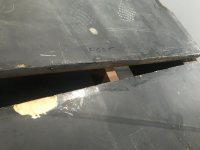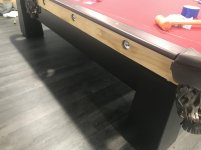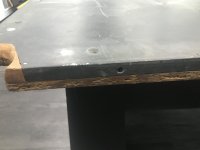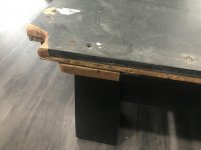Basically, someone made or fitted a new set of rails to an old T-rail table.
They also took off & discarded any of the wood curtains that might have helped easily determine what model. Then they painted it black over any identifying veneer characteristics.
The legs (about all that can be usefully seen in your photo) suggest it *could* have been BBC.
Brunswick didn't really start making simple straight taper legs until the "Alexandria" in 1910 or 11. Same year, "St. Elmo" had simple square straight legs. Your's is not likely either of those because of some other obvious differences. I'm just putting an earliest date out there, if it is BBC.
Madison, as Trent suggested, came along about 1916 & had a long run into the 20's. The legs on Madison did not seem to taper, though. During the 20's, there were a number of tables with similar legs. If you can see any veneer patterns under the paint on the legs, it can ID the table.
By the end of the 20's & the start of the depression, this style of table was moribund. I think the Exhibition might have still been a T-rail? Not sure.
So based on the legs & making a good faith guess that it is BBC, it would have been made between 1911 & 1930.
Based on the slate, i didn't think they still made that type of wood inlay pocket shelf/cut-out after WW1 But I don't really know. I've seen (& own one) tables/slates from the mid 1920's & pocket cuts are completely in slate (no wood) by then.
I have worked on cabinets (wood parts of tables) and slate & made tools & parts for a table builder during the late 70's/80's. I am not a tech & have no set up experience.
I have heard some techs comment WTTE that T-rails can be made to play as well as anything; but might require tweaking a little more often.
When John switched from T-rail assembly of his tables, he said how much easier it was to build them bolted through (like GC) & how they stayed tight longer. YMMV
Or it could be like RKC said; & they found frame & legs one place, slates somewhere else, & made a set of rails to pull it all together.
You are the only one with eyes on it to report how successful the operation was.

smt



